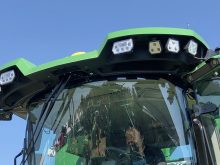A new camelina facility has opened in Montana, which may allow the Cinderella crop to finally get to the ball.
Sustainable Oils officially unveiled its headquarters in Great Falls on June 23. The company, a subsidiary of a California firm called Global Clean Energy, promotes itself as the largest camelina breeder, seed producer and grain buyer in the world.
Sustainable Oils contracts camelina production in the state. The oil from the camelina will be used to produce renewable diesel at Global Clean Energy’s refinery in Bakersfield, Calif.
Read Also

VIDEO: Catch up with the Western Producer Markets Desk
The Western Producer Markets Desk provides daily updates on agricultural markets, with recent video commentary including looks into canola, wheat, cattle and feed grains.
“With the opening of our North American headquarters, Sustainable Oils is poised to be a leader in camelia production worldwide, enhancing economic opportunities for rural agricultural communities while producing some of the lowest carbon renewable fuel feedstock in the world,” said Richard Palmer, Global Clean Energy chief executive in a news release.
Renewable diesel is different from biodiesel and is often described as a second-generation biofuel. Biodiesel must be blended with petroleum diesel, but renewable diesel can be used as a standalone product to replace diesel.
The petroleum and agriculture industries have announced huge investments into renewable diesel projects in Canada and the U.S.:
• Parkland Corp plans to build a $600 million renewable diesel plant in Burnaby, B.C.
• Federated Co-op intends to construct a $2 billion canola crushing and renewable diesel plant in Regina.
• Marathon is now operating a plant in Dickinson, North Dakota, which processes soybean and corn oil into renewable diesel.
The feedstock for these plants will vary, but camelina is suited for renewable diesel. It’s often grown on marginal cropland; it requires less fertilizer than other crops and camelina oil has desirable properties for fuel production.
“Renewable diesel produced from camelina is a drop-in replacement for traditional diesel, but with fewer contaminants and far less emissions,” Sustainable Oils said in a release. “In fact, camelina has the potential to receive the lowest carbon intensity score of available feedstocks on the market.”
There may be demand, but camelina remains a tiny acreage crop in the Northern Plains and Canadian Prairies.
Last year, Sustainable Oils contracted about 15,000 acres and the crop averaged about 750 pounds per acre in Montana, agupdate.com reported in 2021.
In Saskatchewan, acres have been stuck at 5,000 to 20,000 for years.
Camelina has been slow to take off, despite projections of hundreds of thousands or millions of acres in the region.
In 2007, Biodiesel Magazine wrote a piece with the headline, Crazy for Camelina, with quotes from politicians and ag scientists promoting the oilseed’s potential in Montana.
“This is a low-input crop that doesn’t have to compete with the food industry and could add about four million acres of production to Montana agriculture,” said Duane Johnson, superintendent of the Northwestern Agricultural Research Center in Havre, Mont., back in 2007. “So, we’re really excited.”
That projection was optimistic, as camelina has struggled to reach tens of thousands of acres in the Northern Plains.
Sustainable Oils didn’t mention an acreage target in its news release, but the company is working with about 100 growers in Montana.
Other companies are also contracting acres and encouraging camelina production in Montana, Alberta and Saskatchewan.
Yield10 Bioscience, a plant breeding company from Massachusetts, has developed a winter camelina and is seeking farmers to grow the crop.
“We look forward to engaging with farmers to introduce the positive attributes of winter camelina and the role it could play as a cover crop and in crop rotations,” said Darren Greenfield, senior director of seed operations at Yield10 Bioscience, in a June 22 news release.
“I am confident that winter camelina will be a successful crop for growers in the U.S. and Canada, specifically within the regions of Montana, Idaho, Alberta and Saskatchewan. Our efforts during this winter season will be our first steps toward partnering with farmers to drive adoption of this promising new oilseed crop.”
Smart Earth Camelina, a crop breeding and production company in Saskatoon, is also trying to boost camelina adoption in Saskatchewan.
It has developed a herbicide-tolerant camelina, which should convince more farmers to give the crop a try.
“The development of our herbicide-resistant NewGold camelina variety… signals that after more than a decade of development, camelina is in the mainstream of oilseed crops available to growers in Western Canada,” said Jack Grushcow, Smart Earth Camelina president and chief executive officer.
Camelina may not become a mainstream crop in Western Canada or the U.S. Northern Plains.
But with the renewable diesel boom, herbicide-tolerant varieties and winter varieties now on the market, camelina could become a viable option on thousands of grain farms in the region.
Contact robert.arnason@producer.com
















